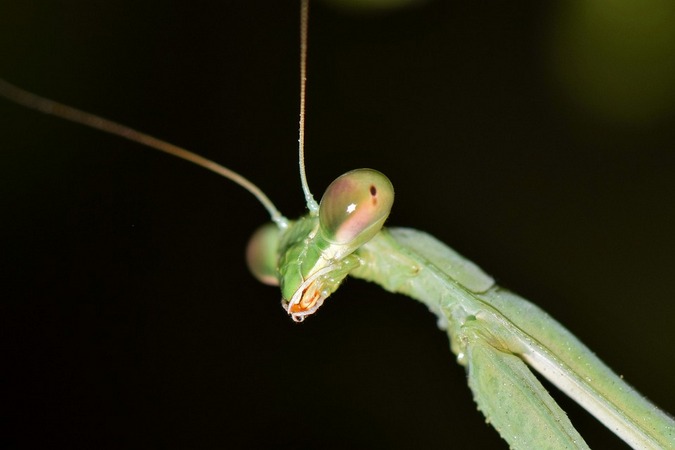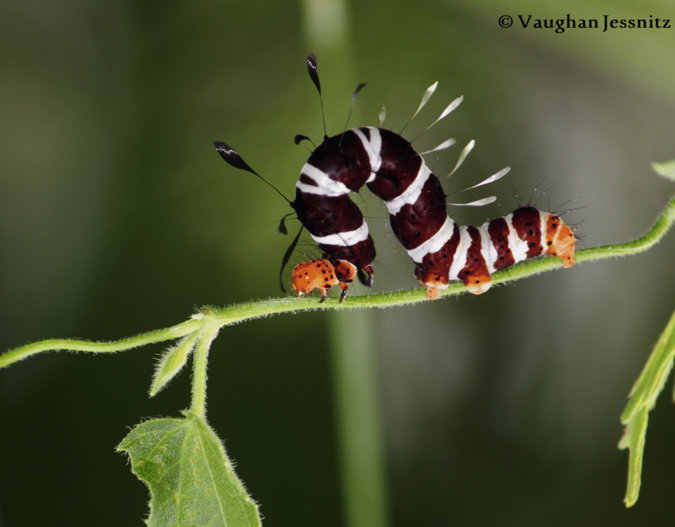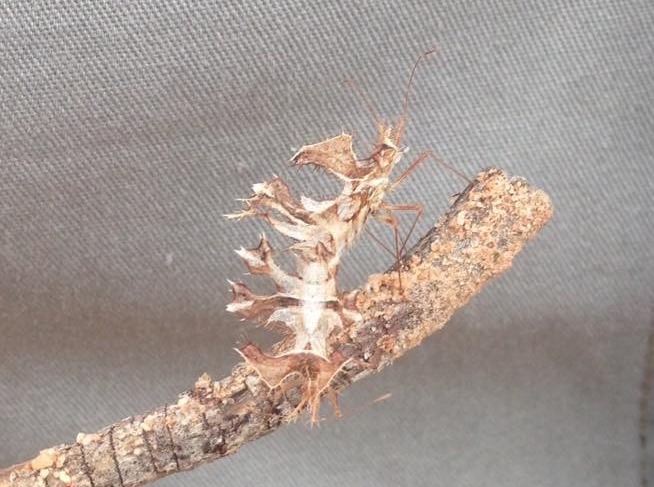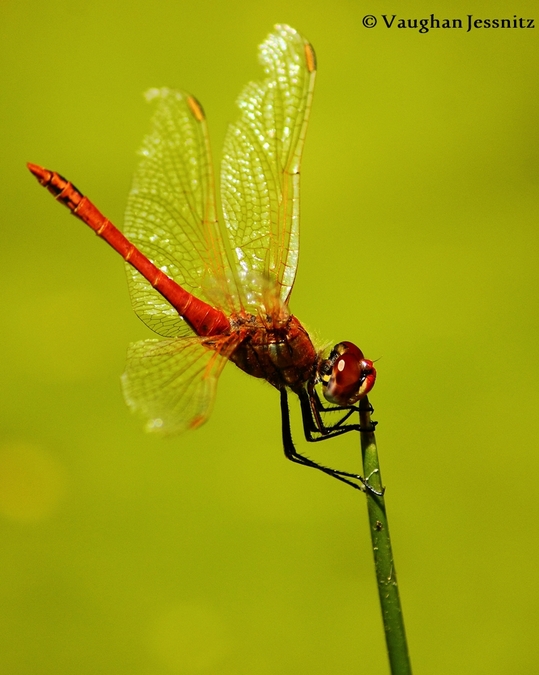Bug Watch - Invertebrate images.
Moderator: Klipspringer
Re: Bug Watch - Invertebrate images.
The yellow bug is an Ovaleye Spittlebug, family Aphrophoridae, perhaps a Ptyelus sp.
-
Tadrisa
- Posts: 6
- Joined: Tue Apr 26, 2016 7:38 pm
- Country: Tanzania
- Location: Singida, Tanzania
- Contact:
Re: Bug Watch - Invertebrate images.
Yeah, in GESS, S.K. & GESS, F.W. 2014. Wasps and bees in southern Africa. SANBI Biodiversity Series 24. South African National Biodiversity Institute, Pretoria. available at http://www.sanbi.org/sites/default/file ... ies-24.pdf page 73, there's a picture of our wasp and prey and it says the wasp is Gorytes natalensis and their specialized prey Ptyelus grossus
- Lisbeth
- Site Admin
- Posts: 67370
- Joined: Sat May 19, 2012 12:31 pm
- Country: Switzerland
- Location: Lugano
- Contact:
5 Intriguing insects found in the African bush
Posted: April 17, 2018

Spiny flower mantis (Pseudocreobotra wahlbergi) © Bushwise
Written by Ben Coley from Bushwise
The African bush is full of fascinating wildlife, both great and small. But sometimes the small gets overshadowed by the big… but not this time! Here we share with you five intriguing insects that are definitely worth keeping an eye out whilst on safari.
Praying mantis (Mantidae family)
Mantids are some of the most recognisable insects in the bush and their host of interesting facets is far too numerous to mention in one short paragraph, but suffice to say these voracious predators are fascinating animals!
Perhaps their biggest claim to fame is the somewhat unorthodox mating behaviour. During the act of mating, it is quite common for the females to cannibalise the males, and not just after the event, but during!! The impulses that control the males’ actions are not contained in its head and thus even after losing it, the mating act can continue. Not only that, but research has shown the males that have their head eaten during copulation are far more successful in passing on viable sperm to the female.
This seems excessive, but considering that, at its most basic level, every animal’s ultimate goal is to pass on its genetics, this is a great (although extreme!) way to ensure successful fertilisation! The males’ ultimate sacrifice also aids its potential offspring by providing the female with a boost of essential protein and energy which will also increase their offspring’s chances of survival.

Mantids have an unorthodox mating behaviour
Millipede assassin bug (Ectrichodia crux)
Millipedes are like armoured tanks rumbling through the bushveld after the rains. Despite their impressive armour and lethal concoction of toxic chemicals, millipedes too have their predators. One such bug is the aptly named millipede assassin.
Easily recognisable by its yellow-lined carapace (the nymphs hunt in packs and are bright red in colour), the millipede assassin bug has a long proboscis used to penetrate the weak spots between a millipede’s segments, injecting a variety of digestive enzymes that paralyse and begin to liquefy the body contents! It is also thought that the (almost instant) paralysis prevents the targeted millipede from discharging its defensive secretions, thus rendering them useless!

A millipede assassin bug is a millipede’s worse enemy © Bushwise
Dice moth caterpillar (Rhanidophora ridens)
The dice moth (in its adult form) is a fairly non-descript member of the bushveld community. However, during its larval stage it is one of the most recognisable and beautiful sights to be found in nature.
The dice moth caterpillar comes in a stunning royal purple and has a host of thin paddle-like protrusions lining its back. These appendages are waved around while resting – perhaps to help the caterpillar mimic moving vegetation and blend into its surroundings. The spectacular colour is considered aposematic colouration, a term which is used to describe species that are distasteful to predators. Regardless of the reasoning, the dice moth caterpillar is one of the most striking and stunning organisms to discover!

A dice moth caterpillar © Vaughan Jessnitz / Bushwise
Twig-wilters (Coreidae family, Pephricus genus)
Although there is very little literature on the Pephricus genus, this member of the Coreidae family is visually unique. It is the direct opposite of the aforementioned dice moth caterpillar that advertises its presence by aposematic colouration. This small bug has one of the greatest cryptic camouflages found in nature. Its delicate, flange-like extensions perfectly mimics a dead leaf and is thus frequently overlooked.
It is often found feeding off the sap of grasses (hence the name). Regardless of the lack of information, it is a great opportunity to discuss the intricate nature of its morphology.

A camouflaged twig-wilter on a stick © Bushwise
Dragonflies
Dragonflies are common place, especially around dams and rivers. There are plenty of interesting facets of their behaviour to discuss but perhaps the most interesting is their eyesight.
Few people realise that dragonflies are excellent hunters and rarely miss any prey that they set their mind to. Due to the incredibly complex compound eyes, they possess an incredible ability to interpret colours. Human eyes have three visual cells (red, blue and green) from which all our colours are created. Dragonflies have at least 11 different receptors, with some species having as many of 30!
Not only that, but their eyes are able to interpret data at such incredible speeds that their reaction time is almost indescribable! Humans’ eyes can process information at a rate of about 50 frames a second. This is why when we watch a movie, we see a seamless, continuous image despite that fact that it is actually a rapid series of still images. A dragonfly can see up to 300 frames per second and therefore would see our movies as a rather laborious slide show and nothing more. This allows them to view and process images at such speed that decisions regarding trajectories for intercepting prey can be calculated to a huge level of accuracy. Studies have shown a successful hunting percentage of around 97%! An incredible feat for a common place predator!

A red dragonfly at rest © Vaughan Jessnitz / Bushwise
Source: https://africageographic.com/blog/5-int ... 3cf4ca8e69

Spiny flower mantis (Pseudocreobotra wahlbergi) © Bushwise
Written by Ben Coley from Bushwise
The African bush is full of fascinating wildlife, both great and small. But sometimes the small gets overshadowed by the big… but not this time! Here we share with you five intriguing insects that are definitely worth keeping an eye out whilst on safari.
Praying mantis (Mantidae family)
Mantids are some of the most recognisable insects in the bush and their host of interesting facets is far too numerous to mention in one short paragraph, but suffice to say these voracious predators are fascinating animals!
Perhaps their biggest claim to fame is the somewhat unorthodox mating behaviour. During the act of mating, it is quite common for the females to cannibalise the males, and not just after the event, but during!! The impulses that control the males’ actions are not contained in its head and thus even after losing it, the mating act can continue. Not only that, but research has shown the males that have their head eaten during copulation are far more successful in passing on viable sperm to the female.
This seems excessive, but considering that, at its most basic level, every animal’s ultimate goal is to pass on its genetics, this is a great (although extreme!) way to ensure successful fertilisation! The males’ ultimate sacrifice also aids its potential offspring by providing the female with a boost of essential protein and energy which will also increase their offspring’s chances of survival.

Mantids have an unorthodox mating behaviour
Millipede assassin bug (Ectrichodia crux)
Millipedes are like armoured tanks rumbling through the bushveld after the rains. Despite their impressive armour and lethal concoction of toxic chemicals, millipedes too have their predators. One such bug is the aptly named millipede assassin.
Easily recognisable by its yellow-lined carapace (the nymphs hunt in packs and are bright red in colour), the millipede assassin bug has a long proboscis used to penetrate the weak spots between a millipede’s segments, injecting a variety of digestive enzymes that paralyse and begin to liquefy the body contents! It is also thought that the (almost instant) paralysis prevents the targeted millipede from discharging its defensive secretions, thus rendering them useless!

A millipede assassin bug is a millipede’s worse enemy © Bushwise
Dice moth caterpillar (Rhanidophora ridens)
The dice moth (in its adult form) is a fairly non-descript member of the bushveld community. However, during its larval stage it is one of the most recognisable and beautiful sights to be found in nature.
The dice moth caterpillar comes in a stunning royal purple and has a host of thin paddle-like protrusions lining its back. These appendages are waved around while resting – perhaps to help the caterpillar mimic moving vegetation and blend into its surroundings. The spectacular colour is considered aposematic colouration, a term which is used to describe species that are distasteful to predators. Regardless of the reasoning, the dice moth caterpillar is one of the most striking and stunning organisms to discover!

A dice moth caterpillar © Vaughan Jessnitz / Bushwise
Twig-wilters (Coreidae family, Pephricus genus)
Although there is very little literature on the Pephricus genus, this member of the Coreidae family is visually unique. It is the direct opposite of the aforementioned dice moth caterpillar that advertises its presence by aposematic colouration. This small bug has one of the greatest cryptic camouflages found in nature. Its delicate, flange-like extensions perfectly mimics a dead leaf and is thus frequently overlooked.
It is often found feeding off the sap of grasses (hence the name). Regardless of the lack of information, it is a great opportunity to discuss the intricate nature of its morphology.

A camouflaged twig-wilter on a stick © Bushwise
Dragonflies
Dragonflies are common place, especially around dams and rivers. There are plenty of interesting facets of their behaviour to discuss but perhaps the most interesting is their eyesight.
Few people realise that dragonflies are excellent hunters and rarely miss any prey that they set their mind to. Due to the incredibly complex compound eyes, they possess an incredible ability to interpret colours. Human eyes have three visual cells (red, blue and green) from which all our colours are created. Dragonflies have at least 11 different receptors, with some species having as many of 30!
Not only that, but their eyes are able to interpret data at such incredible speeds that their reaction time is almost indescribable! Humans’ eyes can process information at a rate of about 50 frames a second. This is why when we watch a movie, we see a seamless, continuous image despite that fact that it is actually a rapid series of still images. A dragonfly can see up to 300 frames per second and therefore would see our movies as a rather laborious slide show and nothing more. This allows them to view and process images at such speed that decisions regarding trajectories for intercepting prey can be calculated to a huge level of accuracy. Studies have shown a successful hunting percentage of around 97%! An incredible feat for a common place predator!

A red dragonfly at rest © Vaughan Jessnitz / Bushwise
Source: https://africageographic.com/blog/5-int ... 3cf4ca8e69
"Education is the most powerful weapon which you can use to change the world." Nelson Mandela
The desire for equality must never exceed the demands of knowledge
The desire for equality must never exceed the demands of knowledge
- Lisbeth
- Site Admin
- Posts: 67370
- Joined: Sat May 19, 2012 12:31 pm
- Country: Switzerland
- Location: Lugano
- Contact:
Re: 5 Intriguing insects found in the African bush
I thought that it was nice 
"Education is the most powerful weapon which you can use to change the world." Nelson Mandela
The desire for equality must never exceed the demands of knowledge
The desire for equality must never exceed the demands of knowledge
- Richprins
- Committee Member
- Posts: 75948
- Joined: Sat May 19, 2012 3:52 pm
- Location: NELSPRUIT
- Contact:
Re: 5 Intriguing insects found in the African bush
Please check Needs Attention pre-booking: https://africawild-forum.com/viewtopic.php?f=322&t=596
Re: 5 Intriguing insects found in the African bush
Quote : " Here we share with you five intriguing insects that are definitely worth keeping an eye out whilst on safari. "
Very very interesting But not very visible while travelling at speed
But not very visible while travelling at speed 
Very very interesting
Enough is enough
Re: AW Insect Book: Sawflies, Wasps, Bees & Ants (Hymenoptera)
Cape Honey bees -- Apis mellifera capensis - drinking fresh rainwater .
Pic taken here on the farm .
Pic taken here on the farm .
Enough is enough
- Lisbeth
- Site Admin
- Posts: 67370
- Joined: Sat May 19, 2012 12:31 pm
- Country: Switzerland
- Location: Lugano
- Contact:
Butterflies of the Maasai Mara
Posted 20.09.2018

African swallowtail © Alisa Bowen
The rolling savanna grass plains of the Maasai Mara may not automatically spring to mind as a hotspot for butterfly diversity; yet lepidopterists and amateur butterfly lovers alike are in for a treat when they stay at one of the Governors’ Camp Collection properties............

African swallowtail © Alisa Bowen
The rolling savanna grass plains of the Maasai Mara may not automatically spring to mind as a hotspot for butterfly diversity; yet lepidopterists and amateur butterfly lovers alike are in for a treat when they stay at one of the Governors’ Camp Collection properties............
"Education is the most powerful weapon which you can use to change the world." Nelson Mandela
The desire for equality must never exceed the demands of knowledge
The desire for equality must never exceed the demands of knowledge


